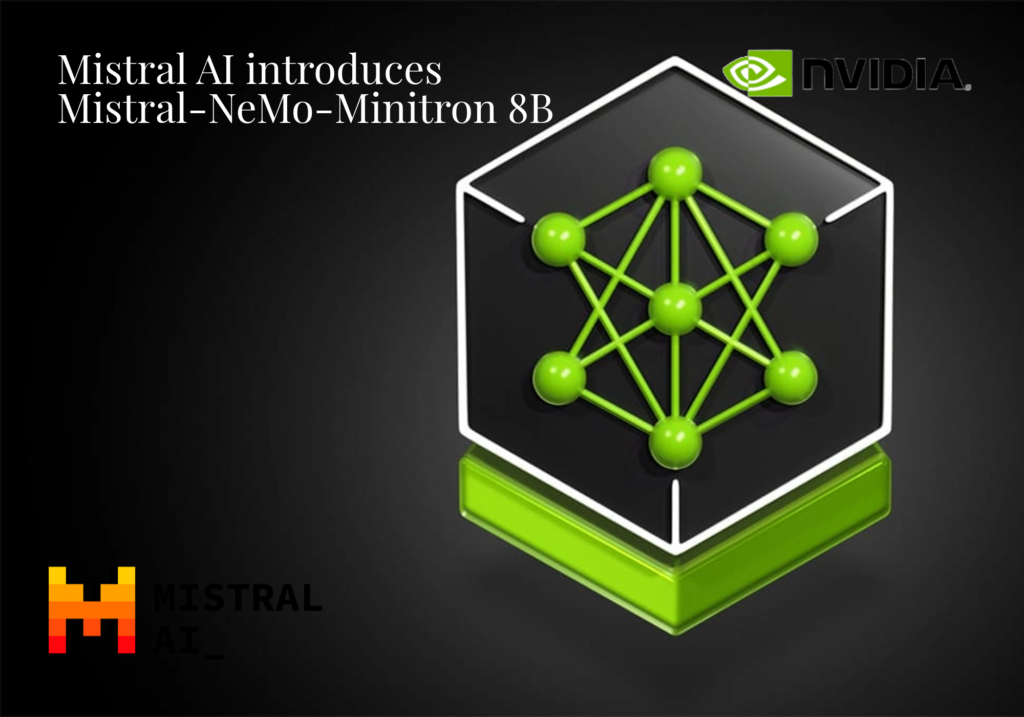With 12 billion parameters and a focus on accessibility, Mistral-NeMo-Minitron 8B is set to democratize AI and drive innovation in NLP.
Introduction:
In the rapidly evolving landscape of artificial intelligence, large language models have emerged as a game-changer, revolutionizing natural language processing (NLP) and enabling applications like chatbots, text generation, and machine translation. Now, Paris-based startup Mistral AI, in collaboration with NVIDIA, has released Mistral-NeMo-Minitron 8B, an open-source large language model with 12 billion parameters. This groundbreaking model promises to advance the field of NLP, making AI more accessible and fostering innovation. Let’s delve into the architecture, training process, performance, applications, and ethical considerations.
Architecture: A Deep Dive into Mistral-NeMo-Minitron 8B’s Design
The model is built on the Transformer architecture, a popular design for large language models that uses self-attention mechanisms to weigh the importance of input words. The model consists of 40 layers, each containing around 160 billion parameters, making it one of the largest open-source language models available.
“With Mistral-NeMo-Minitron 8B, we aimed to create a model that balances size and efficiency,” explains Arthur Mensch, co-founder and CEO of Mistral AI. “We wanted to provide the NLP community with a powerful tool that can run on accessible hardware, driving further research and innovation.”
Read more: Meet James: NVIDIA’s New Digital Human That Feels Almost Human
Training: Harnessing the Power of Data
To train the model, Mistral AI used a combination of public data, such as Wikipedia and books, along with proprietary data from their own projects. The model was trained using the Megatron-LM framework developed by NVIDIA, which optimizes large language models for efficient training on multiple GPUs.
“We’re grateful for NVIDIA’s collaboration in developing Mistral-NeMo-Minitron 8B,” says Mensch. “Their expertise in hardware and software optimization has been invaluable in creating a model that’s both powerful and accessible.”
Performance: Benchmarking Mistral-NeMo-Minitron 8B
Preliminary results show that the model performs competitively with other large language models. On the Massive Multitask Language Understanding (MMLU) benchmark, which evaluates a model’s ability to perform various NLP tasks, it achieved a score of 57%, on par with other 12-billion parameter models like Bloom and OPT.
“We’re really impressed with the model’s performance, given its size and efficiency,” says Emily M. Bender, a professor of linguistics at the University of Washington who has evaluated the model. “It’s a significant addition to the open-source NLP ecosystem.”
Read more: Mistral AI Unveils Mistral Large 2: A Giant Leap in Large Language Models
Applications: Unleashing the Potential of Large Language Models
With its impressive performance and accessibility, the AI model has the potential to drive innovation in various industries. Some of its applications include:
- Text Generation: The model can generate coherent and contextually relevant text, making it useful for content creation, summarization, and translation tasks.
- Chatbots and Virtual Assistants: The model’s ability to understand and generate human-like text enables more natural and engaging conversations with AI-powered chatbots and virtual assistants.
- Machine Translation: It can help improve the accuracy and fluency of machine translation, breaking down language barriers and facilitating global communication.
Ethical Considerations: Responsible AI with Mistral-NeMo-Minitron 8B
While large language models like Mistral-NeMo-Minitron 8B offer immense potential, they also raise ethical considerations. These models can inadvertently perpetuate biases present in their training data, leading to unfair or discriminatory outputs. Additionally, they can generate misleading or harmful content if not used responsibly.
Mistral AI acknowledges these challenges and emphasizes the importance of responsible AI practices. “We believe that open-source models like Mistral-NeMo-Minitron 8B can help advance the field of AI ethically,” says Mensch. “By making our model accessible, we hope to encourage research into mitigating biases and developing safer, more transparent AI systems.”
Open Source: Empowering the NLP Community
This AI model is released under the Apache 2.0 license, making it freely available for research and commercial use. This open-source approach enables the NLP community to build upon, fine-tune, and improve the model, fostering collaboration and innovation.
“Open-source models like Mistral-NeMo-Minitron 8B are crucial for the progress of NLP,” says Timothée Lacroix, a researcher at the French National Institute for Computer Science and Automation (INRIA). “They allow us to push the boundaries of what’s possible, both in terms of model size and accessibility.”
Conclusion – A New Chapter in NLP
Mistral AI’s Mistral-NeMo-Minitron 8B is more than just a large language model – it’s a testament to the power of collaboration, accessibility, and open-source innovation. With its impressive performance, efficient design, and commitment to responsible AI practices, it is poised to drive progress in the field of NLP and beyond.
As the AI landscape continues to evolve, models like Mistral-NeMo-Minitron 8B will play an increasingly important role in shaping our future. By democratizing access to large language models and fostering collaboration, The model is helping to write the next chapter in the story of artificial intelligence.
Relevant Resources:
- Download the Mistral-NeMo-Minitron 8B model from Hugging Face
- Megatron-LM framework: https://github.com/NVIDIA/Megatron-LM


